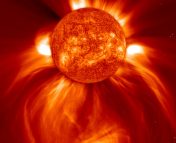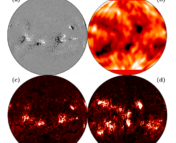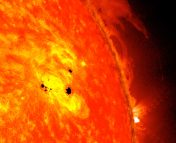Title: The Sun is less active than Solar-like stars
Authors: Timo Reinhold, Alexander I. Shapiro, Sami K. Solanki, Benjamin T. Montet, Nathalie A. Krivova, Robert H. Cameron, Eliana M. Amazo-Gomez
First Author’s Institution: Max Planck Institute for Solar System Research, Gottingen, Germany
Status: Accepted for publication in Science, available on arxiv.
The Sun’s dynamo is the process that generates its magnetic field, which leads to the creation of sunspots, and eventually to solar flares. These flares create a temporary increase in brightness on the Sun. This process is defined as solar activity.
For decades, astronomers have wondered whether stars similar to our Sun presented a similar variance in their brightnesses. The Kepler space telescope’s precise brightness measurements have enabled the detection of photometric variability, which is how much the photon count of an object varies with time, of over 100,000 stars in our galaxy. The photometric variability of stars is directly related to their magnetic activity: the more variable a star’s photon count is, the more magnetically active it is.
The authors of today’s paper use Kepler data combined with Gaia astrometry to measure the activity of “Sun-like stars” – stars with nearly identical effective temperatures, surface gravities, metallicities, and rotation periods to the Sun. They find that the median variability of Sun-like stars is 5 times higher than the median variability of the Sun, and attempt to explain why the Sun appears to be less active than its contemporaries. This result could shed light (pun intended) on how stellar activity evolves as a star ages, and tell us more about how the Sun’s magnetic activity may further evolve with time. Understanding more about the solar dynamo is important because changes in the Sun’s activity levels could have a direct impact on the Earth’s climate and atmosphere.
Finding Sun-like stars
The authors selected the sample of stars with properties similar to that of the Sun’s using HR-diagrams generated from the Kepler and Gaia data (Figure 1). The sample is separated into two sub-groups: “periodic” stars, with detected rotation periods (369 stars) and “non-periodic” stars, with undetected rotational periods (2529 stars). These stars were observed over a period of 4 years.
Comparing Sun-like stars to the Sun
In order to quantify and compare the magnetic activity of these stars to that of the Sun’s, the authors define a quantity called the variability range (Rvar). Rvar is a normalized flux measurement, defined to be the difference between the 95th and 5th percentiles of the measured photon flux values divided by the median flux for each star. The values are then corrected to be closer to the Sun’s parameters of metallicity, surface gravity and rotation period. To determine the Sun’s Rvar , the authors run a simulation on measured total solar irradiance data to simulate how the Sun’s flux would appear if it were seen through Kepler – taking into account its properties as well as any noise that could appear in the data. The authors call this the “Noisy Sun”.
The distribution of Rvar values for the entire Kepler sample is shown in Figure 2. The authors find that the median value of the Sun-like stars’ variability is 5 times higher than the Sun’s median variability, and 1.8 times higher than the maximum solar value for Rvar.. The authors propose two explanations for the different levels of the observed stellar activity. First, there could be differences in the underlying magnetic activity of periodic and non-periodic stars. Prior studies show that the Sun is currently in a low stellar activity state, while stars with defined rotational periods are in high stellar activity states. Second, the distribution of Rvar values for the Sun-like stars could represent all the possible values of solar activity over the Sun’s lifetime, and we just aren’t seeing the Sun in a state of high activity at this time.
While the reason why the Sun currently appears to be less active than other Sun-like stars is not yet fully understood, the authors demonstrate how the Sun can be placed in the context of similar stars in our corner of the Milky Way galaxy. The comparisons presented by the paper can help us understand the Sun’s past, present, and possibly future activity.
Edited by: Jamie Sullivan
Featured image credit: NASA Solar System Exploration





Excellent paper! Congratulations
Thanks Flavio for the lucid review of this important paper.